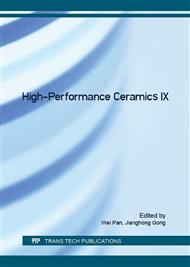[1]
T Shimada, K Touji, Y Katsuyama, et al., Lead free PTCR ceramics and its electrical properties, J. Eur. Ceram. Soc. 27 (2007) 3877–3882.
DOI: 10.1016/j.jeurceramsoc.2007.02.171
Google Scholar
[2]
S L Leng, G R Li, L Y Zheng, et al., Influences of Ba/Ti ratios on the positive temperature coefficient of resistivity effect of Y-doped BaTiO3-(Bi0. 5Na0. 5)TiO3 ceramics, J. Am. Ceram. Soc. 94 (2011) 1340–1342.
DOI: 10.1111/j.1551-2916.2011.04506.x
Google Scholar
[3]
O Saburi, Properties of semiconductive barium titanates, J. Phys. Soc. Jpn. 14 (1959) 1159–1174.
DOI: 10.1143/jpsj.14.1159
Google Scholar
[4]
Y L Chen, S F Yang, PTCR effect in donor doped barium titanate: review of compositions, microstructures, processing and properties, Adv. Appl. Ceram. 110 (2011) 257-269.
DOI: 10.1179/1743676111y.0000000001
Google Scholar
[5]
O I Prokpalo, A V Turlk, Point defects and electrical properties of ferroelectrics, Ferroelectrics 22 (1978) 749-751.
DOI: 10.1080/00150197808237388
Google Scholar
[6]
H D Wu, Y P Pu, Z Wang, et al., Study of electrical and dielectric properties of Y2O3 doped Ba1−x(Bi0. 5Na0. 5)xTiO3 ceramics, Mater. Lett. 76 (2012) 222–225.
DOI: 10.1016/j.matlet.2012.02.105
Google Scholar
[7]
H Takeda, Y Hoshi, T Kinoshita, et al., Fabrication of lead-Free and high Tc BaTiO3-based thermistor ceramics using deoxidizing effect of oxygen-containing α-zirconium, Ceram. Int. 34 (2008) 2073–(2077).
DOI: 10.1016/j.ceramint.2007.08.009
Google Scholar
[8]
Q B Yuan, Y P Pu, Effects of K0. 5Bi0. 5TiO3 addition on dielectric properties of BaTiO3 ceramics, Ceram. Int. 39 (2013) 3507–3510.
DOI: 10.1016/j.ceramint.2012.10.174
Google Scholar
[9]
Y P Pu, J F Wei, Y Q Mao, et al., Positive temperature coefficient of resistivity behavior of niobium-doped (1−x)BaTiO3-xBi0. 5Li0. 5TiO3 ceramics, J. Alloy. Compd. 498 (2010) L5–L7.
DOI: 10.1016/j.jallcom.2010.03.149
Google Scholar
[10]
J C Zhao, L T Li, Z L Gui, Influence of lithium modification on the properties of Y-doped Sr0. 5Pb0. 5TiO3 thermistors, Sensor. Actuat. A 95 (2001) 46-50.
Google Scholar
[11]
S L Leng, G R Li, L Y Zheng, et al., Effect of donor concentration on the PTCR behavior of Y-doped BaTiO3-(Bi1/2Na1/2)TiO3 ceramics, J. Mater. Sci.: Mater. Electron. 24 (2013) 431–435.
DOI: 10.1007/s10854-012-0774-x
Google Scholar
[12]
B Li, Inorganic Dielectric Material, National Defence Industry Press, Beijing, 1980, p.263.
Google Scholar


